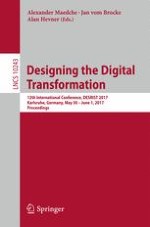This book constitutes the proceedings of the 12th International Conference on Design Science Research in Information Systems and Technology, DESRIST 2017, held in May/June 2017 in Karlsruhe, Germany.
The 25 full and 11 short papers presented in this volume were carefully reviewed and selected from 66 full and 19 short papers. The contributions are organized in topical sections named: DSR in business process management; DSR in human computer interaction; DSR in data science and business analytics; DSR in service science; methodological contributions; domain-specific DSR applications; emerging themes and new ideas; and products and prototypes.
